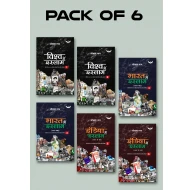Indian Strategic Culture: The Mahabharata and the Kautilyan Ways of War
Short Description
Explore the timeless wisdom of ancient Indian strategic thought in "Mahabharata and Kautilya: Lessons for Modern Warfare." Major General (Dr.) G.D. Bakshi, a decorated combat veteran, delves into the strategic culture and war-fighting methods outlined in these seminal texts, drawing parallels with contemporary military challenges. With a comparative analysis of Kautilya, Machiavelli, and Sun Tzu, this book offers valuable insights for scholars and soldiers alike. Bakshi's extensive military experience and scholarly expertise make this work essential reading for understanding India's traditional knowledge systems and their relevance in modern warfare.
More Information
| ISBN 13 | 9798885751865 |
| Book Language | English |
| Binding | Paperback |
| Publishing Year | 2024 |
| Total Pages | 296 |
| Edition | First |
| Publishers | Garuda Prakashan |
| Category | Non-Fiction Military History History |
| Weight | 310.00 g |
| Dimension | 15.50 x 23.00 x 2.00 |
Product Details
ABOUT THE BOOK:-
Each country has its own distinctive Strategic Culture and Way of War Fighting that evolves over time and tends to outlast the era of its inception. Thus, the Chinese PLA still assiduously studies Sun Zi Bing Fa ( Sun Tzu’s Art of War) that was written in the 3rd Century BCE. They are convinced that this text has valuable lessons for the current era, for it was written in a similar Multi-Polar era of the Warring States. So were the Mahabharata and Kautilya’s Arthashastra written in a similar era of Multi-Polar power equations that had constantly warring maha janapadas (major states) in India.
These two seminal texts represent the quintessential Indian Strategic Culture and way of War-Fighting that is deeply ingrained in our psyche. Today, we need to urgently study our Traditional Knowledge Systems, for they represent our innate genius and way of waging war. Not only do we need to indigenise the design and production of our weapon systems, equally, we need to indigenise our military doctrines and way of waging war. Hence the need to study the Mahabharata’s and Kautilya’s ways of waging war, because they have very significant lessons for us today. The Kautilyan way of war was premised upon waging a long covert campaign of destabilisation and psy-ops to break the balance of the enemy state. Then, a swift and sharp military campaign was launched in the wake of the extended de-stabilisation campaign. Massed war elephants were used to produce shock and awe and speed up the campaign. Amazingly, the same war–fighting design emerged unconsciously in the Bangladesh War of 1971, when, in just 13 days, India broke Pakistan into two and liberated the whole country of Sonar Bangla.
The author has carried out a comparative analysis of Kautilya with Machiavelli and Sun Tzu that would be useful for scholars and soldiers alike.
Major General (Dr.) G.D. Bakshi, SM, VSM (Retd.) is a decorated combat veteran who was commissioned in the 6th Battalion of the Jammu & Kashmir rifles in 1971. He commanded his Battalion, Brigade and Division in active combat environments in J&K. He became a turn-around specialist and turned defeat into victory in very tough assignments. He has authored 46 books and written over 400 papers for prestigious defence journals. A highly popular TV commentator, he lectures extensively on the subjects of leadership, motivation and national security and is a thought leader on these issues. Currently, he is the editor of Indian Military Review, the defense monthly journal that has the largest circulation in India. In 2018, he was conferred the Chandra Shekhar Rashtriya Samman award by the Govt. of Madhya Pradesh.










-(1)_compressed-(1)_page-0001.jpg)












